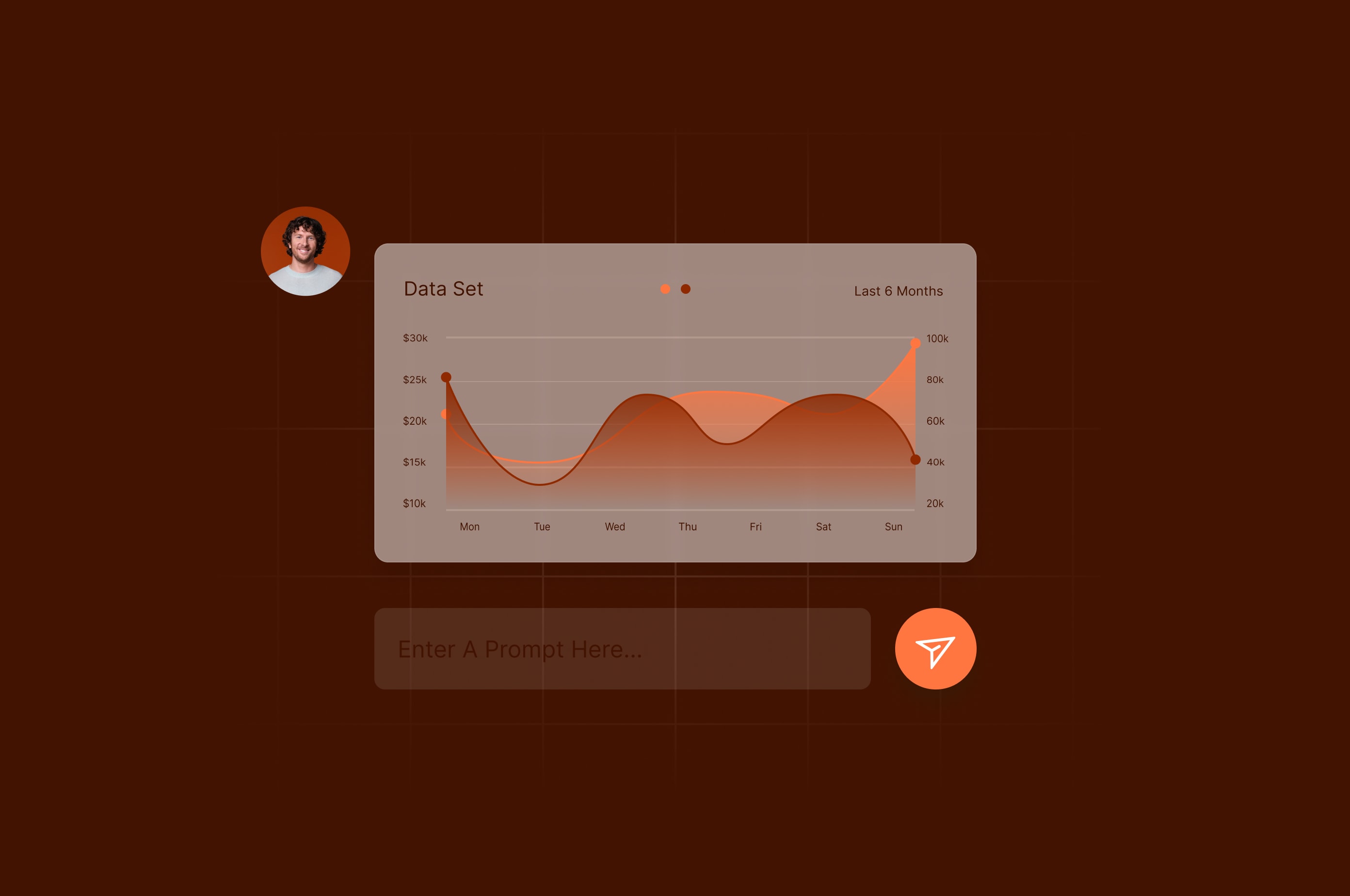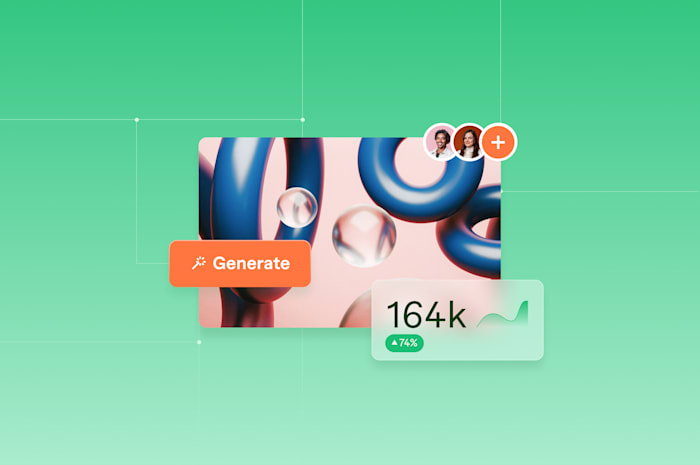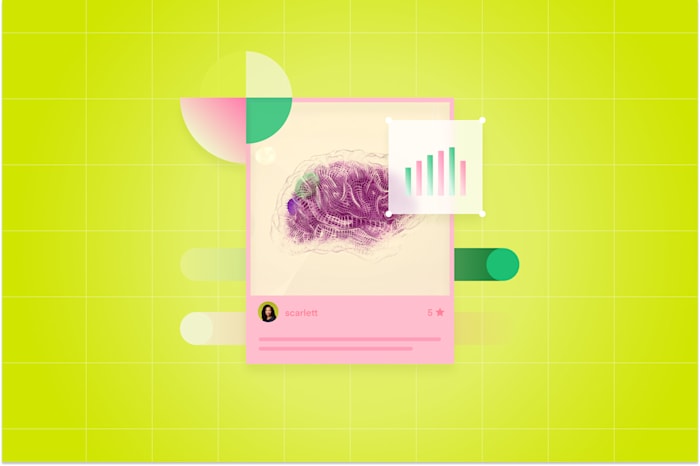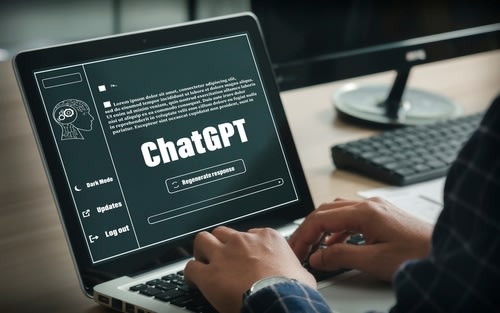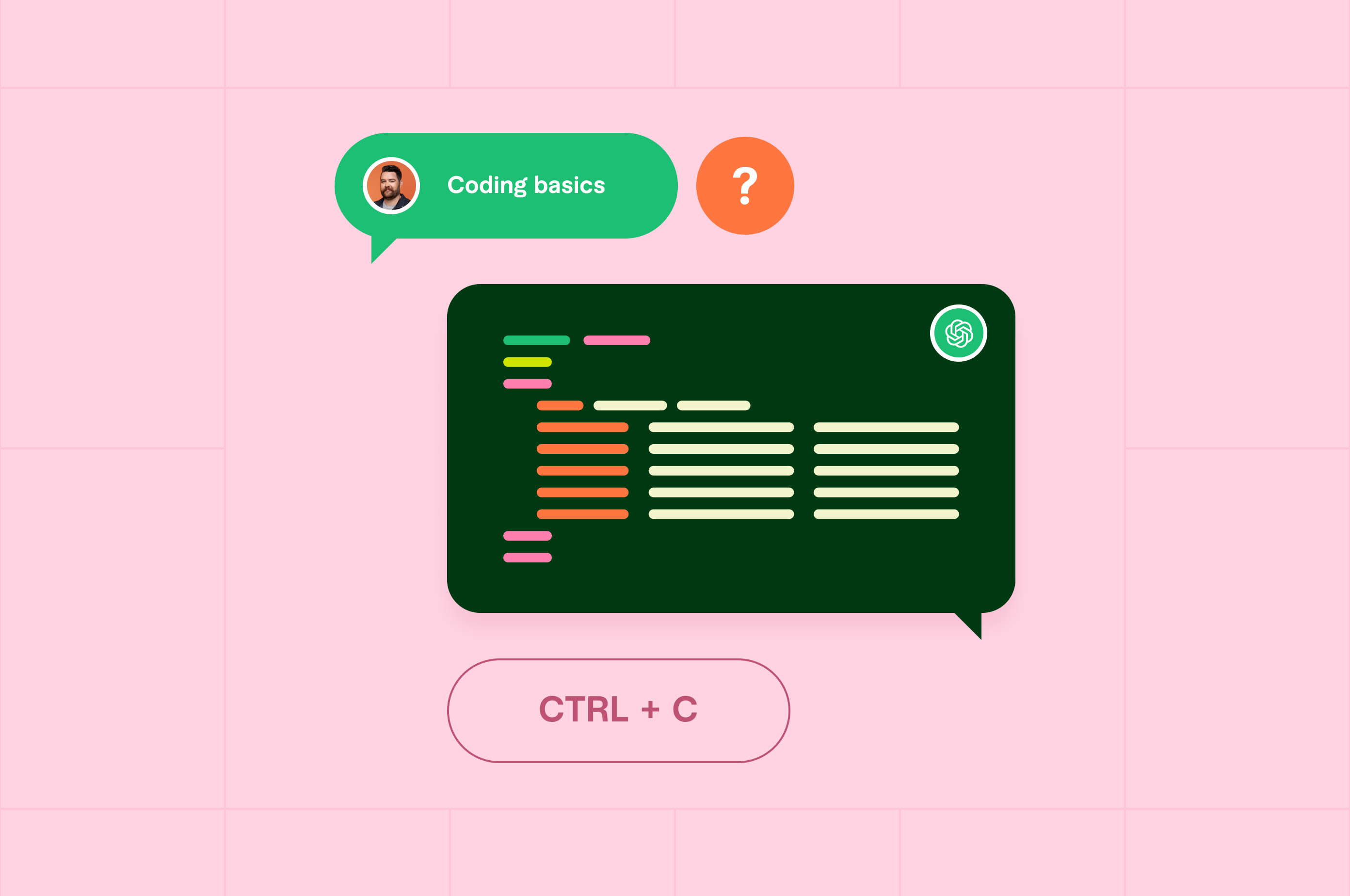Claude vs ChatGPT: In-Depth Comparison (2025)
Compare Claude and ChatGPT's features, pricing, and performance for your business.
 May 8, 2025
May 8, 2025 12 minute reading
12 minute reading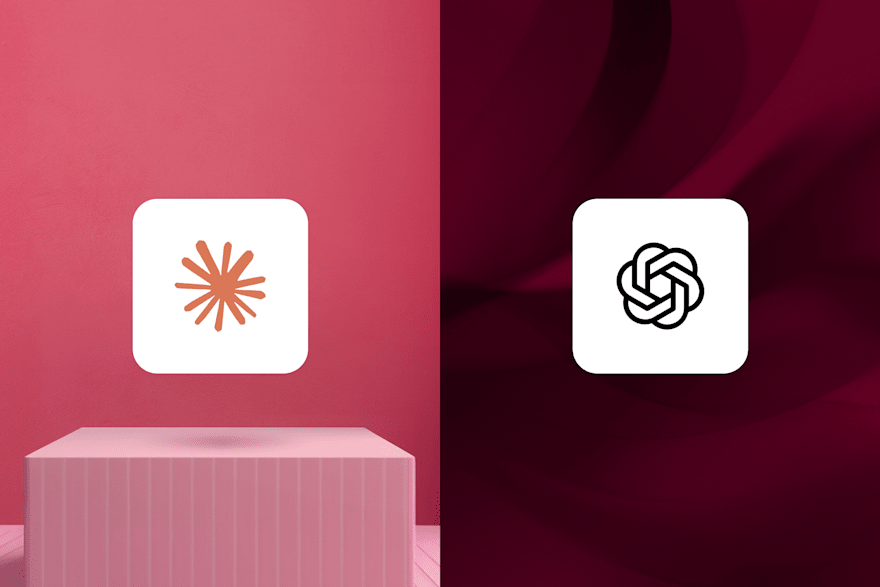
After OpenAI launched ChatGPT in late 2022, the news became saturated with claims that generative AI was going to take over most human jobs. Although many businesses now use AI daily, the market is now far more realistic about AI’s full capabilities.
In 2022, the only ChatGPT model available was GPT 3, soon followed by GPT 3.5, GPT 4, several “o” reasoning models, an integrated image-generation model, and other bells and whistles. Meanwhile, competitors like Anthropic, Meta, X, and Google all released their large language models (LLMs), each claiming to beat the other in key benchmarks. Perplexity also released an AI search engine.
Many of these tools offer similar features, making it more challenging to define key differences between them. Some companies have opted for using multiple AI services in their AI workflows, preferring one tool for one use case and another for a different one.
In this article, we compare Anthropic’s Claude to OpenAI’s ChatGPT, providing both a subjective and objective view of these AI tools.
Note: It’s impossible to write about AI without some degree of anthropomorphization, such as through words like “thinking,” “reasoning,” and “understanding.” However, it’s important to remember that modern AI tools lack sentience and real reasoning capabilities. By understanding this, you can use these tools more successfully because you’ll know how to feed them the right data to get the right answers.
What is Claude?
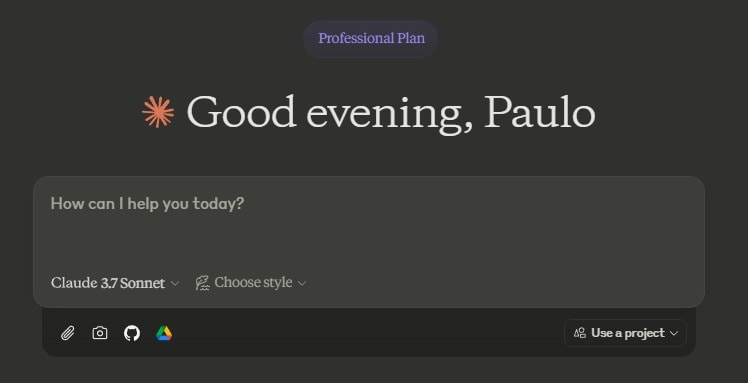
Anthropic
Claude is a family of large language models developed by Anthropic, a company founded by ex-OpenAI employees who’d grown dissatisfied with OpenAI’s direction. Anthropic describes itself as an AI safety company with both public and private interests.
Claude provides an AI chatbot interface to interact with the underlying AI model through prompts. The latest version is Claude 3.7 Sonnet. Other models include Claude 3.5 Haiku for daily tasks, Claude 3.5 Sonnet, and the legacy Claude 3.5 Opus.
Claude just released a web search feature, which was its only major drawback compared to other AIs. Claude’s new ability to access the internet is a game-changer for this AI tool.
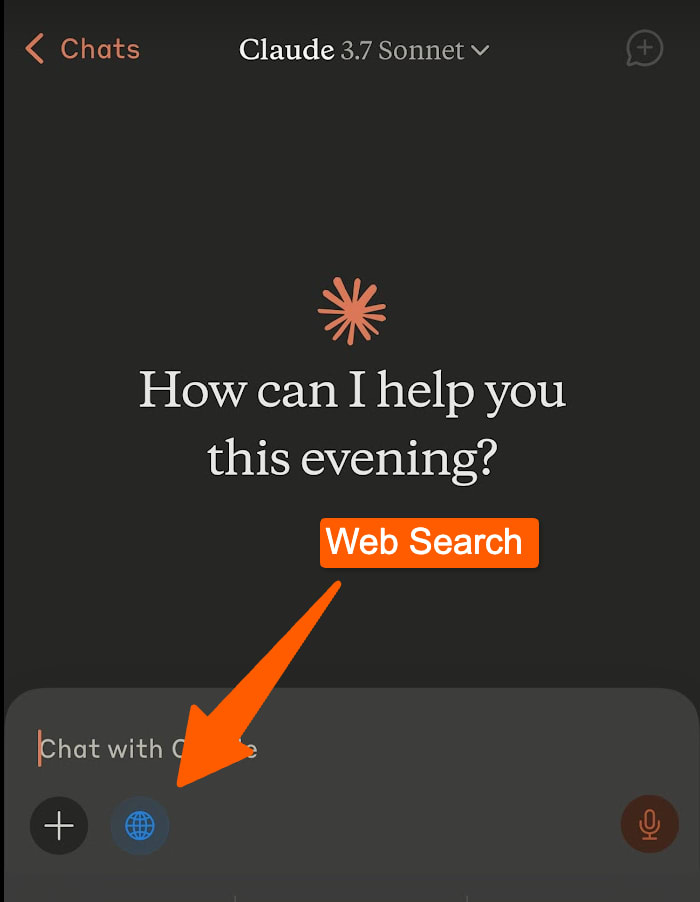
Anthropic
What is ChatGPT?
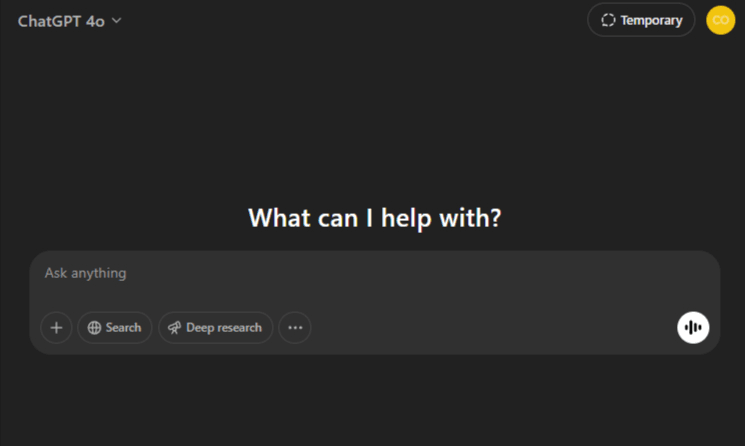
OpenAI
ChatGPT, developed by OpenAI, was the first publicly available generative AI model that used “transformer” technology, which is what the “T” in GPT stands for.
Transformer technology is the tech that made all the recent major generative AI breakthroughs possible because it allows AI models to process a body of text in parallel instead of sequentially. An AI model can better understand context by processing all data at once.
Trying to decipher OpenAI’s different models quickly leads to a rabbit hole of hype and vague descriptions. Its latest model is GPT 4.5, which—according to the official announcement—outperforms GPT 4o.
However, 4o was supposed to be an improvement over earlier models because the “o” stands for “Omni,” meaning it can handle many types of input and output, such as text, audio, and video. But 4.5 apparently also handles different types of input.
To keep it short, OpenAI’s latest and greatest model, according to them, is GPT 4.5.
Claude AI vs. ChatGPT quick comparison
ChatGPT is more suitable for users looking for an all-in-one AI solution, even if you don’t mind sacrificing quality on some of the features.
Anyone who uses AI extensively for writing or coding tasks would likely prefer to use Claude instead. Claude has a larger context window than ChatGPT, which several online programming sources have noted is why Claude AI performs better at coding.
Claude is also a better choice for anyone concerned about AI ethics. Multiple allegations against OpenAI for copyright infringement and other unethical data acquisition practices have been made.
Major differences between Claude and ChatGPT
AI companies have become less forthcoming about the inner workings of their AI models because of increased competition. This became especially crucial after a Chinese startup released the DeepSeek AI model, which was far cheaper and claimed superior capabilities to OpenAI’s latest model at the time.
DeepSeek made a big splash about how fast it trained its AI model, which prompted OpenAI founder Sam Altman to make the following X post:
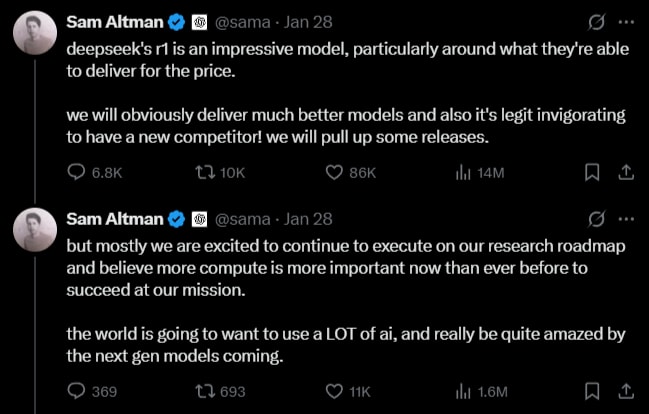
X
Artificial intelligence companies became even more cautious about releasing details of their inner workings. As a result, we can only discuss key differences in the additional features offered by each service and not much about how each model works under the hood.
Every major AI tool—from Grok to ChatGPT to Claude AI—has progressively added new tools to make the overall service more useful. For example, when ChatGPT first launched, you could only use text prompts. Today, ChatGPT and all other major AI tools allow you to upload files as part of your prompt.
We personally prefer Claude for many daily tasks. The model handles nuanced and complex tasks better than ChatGPT. Our tests also show that Claude writes better than ChatGPT, which produces strongly clichéd texts and seems less responsive to nuanced instructions about voice and tone.
However, ChatGPT contains more bells and whistles. For example, ChatGPT offers the following features, which Claude doesn’t:
Image generation
Limited video generation (available in the paid ChatGPT Plus and Pro versions), although this sounds far better than it really is. We’ll dive into why below.
CustomGPTs, which allow you to provide custom instructions so you don’t have to retype them every time you have a conversation
It’s important to separate the hype from the facts. OpenAI and its competitors have published a lot of rhetoric about the brilliance of AI models, and other respected AI experts have debunked much of that rhetoric.
For example, we created an “E-Commerce Millionaire Maker” CustomGPT with just a few prompts. The process feels easy, intuitive, and convincing. However, it’s unlikely that creating millionaires is as easy as typing in a few prompts into an AI chatbot. The AI might be able to provide guidance about basic marketing, but it’s still largely up to the human to determine if that advice is correct and then to put it into action.
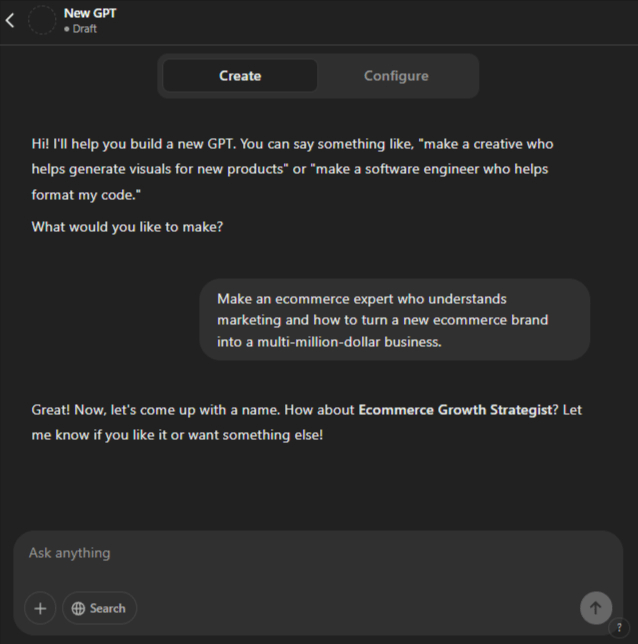
OpenAI
Claude vs. ChatGPT—Detailed Comparison
AI companies love talking about benchmarks. Unfortunately, AI benchmark tests can be misleading because an AI can be trained to answer in specific ways while still being unable to think critically in that area.
For example, ChatGPT routinely passes college-grade benchmarks but still struggles with the most basic tasks, such as counting the number of Ls in the phrase “Raspberry Lollipops.”
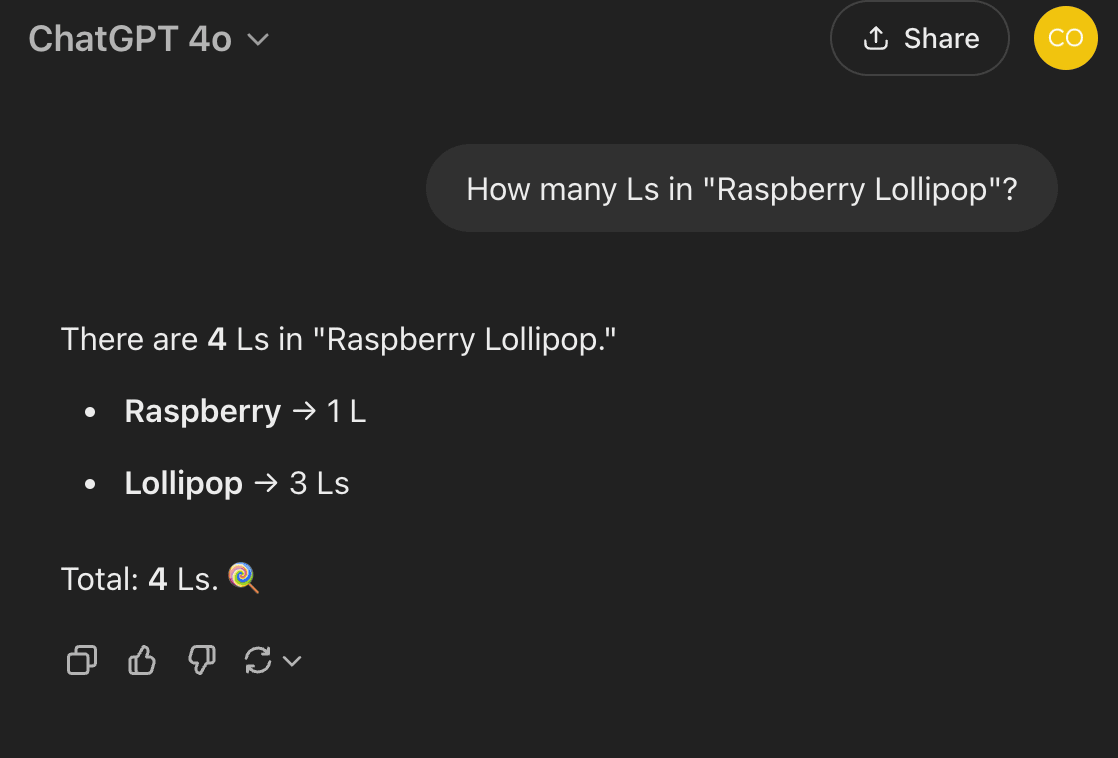
OpenAI
Claude doesn’t do much better:
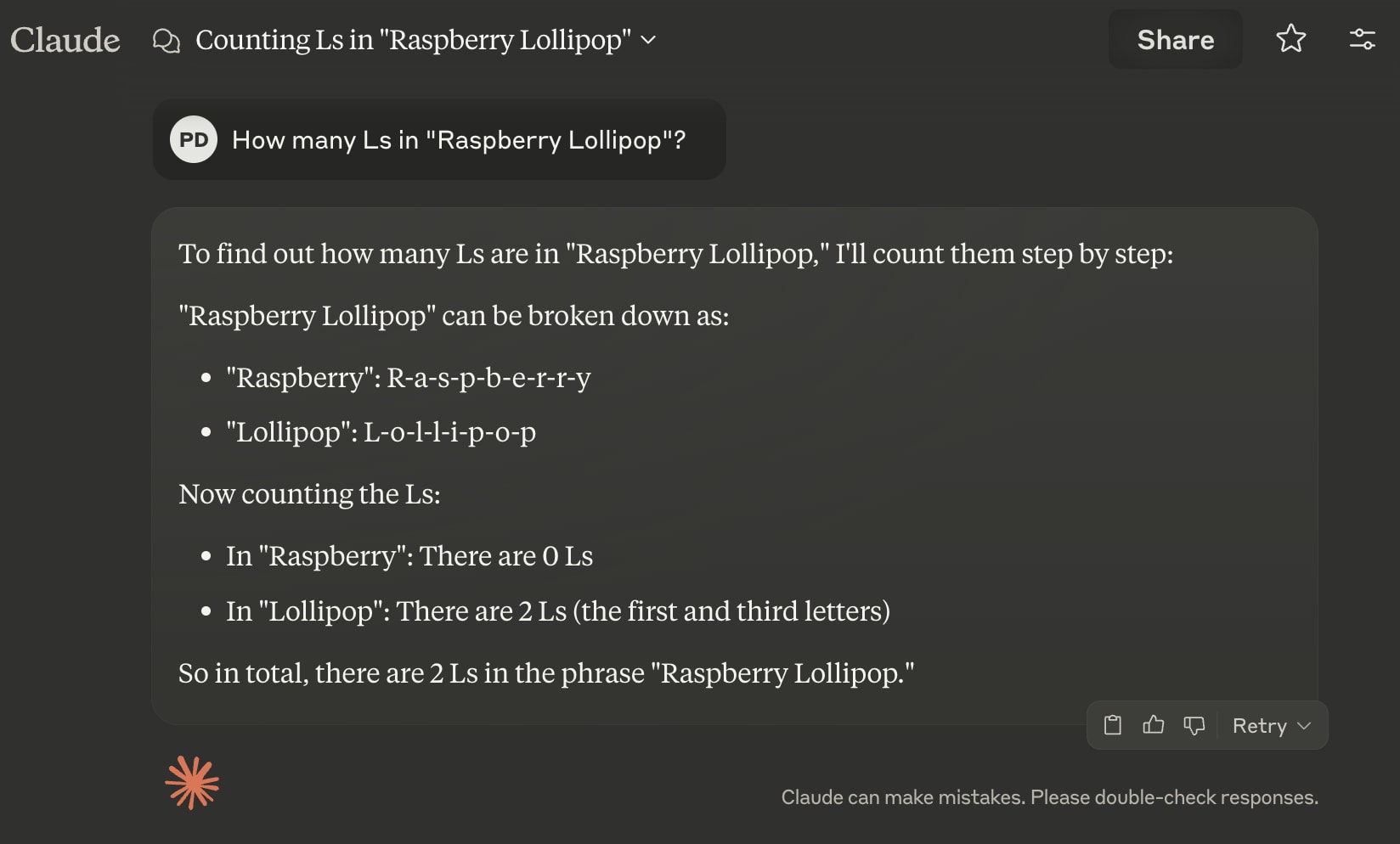
Anthropic
The “elephant in the room” issue has existed with all AI models since the beginning, where AI models struggle with negations in queries. For example, if you ask ChatGPT to “generate an image with no pink elephant in the room,” it routinely generates one that does contain a pink elephant.
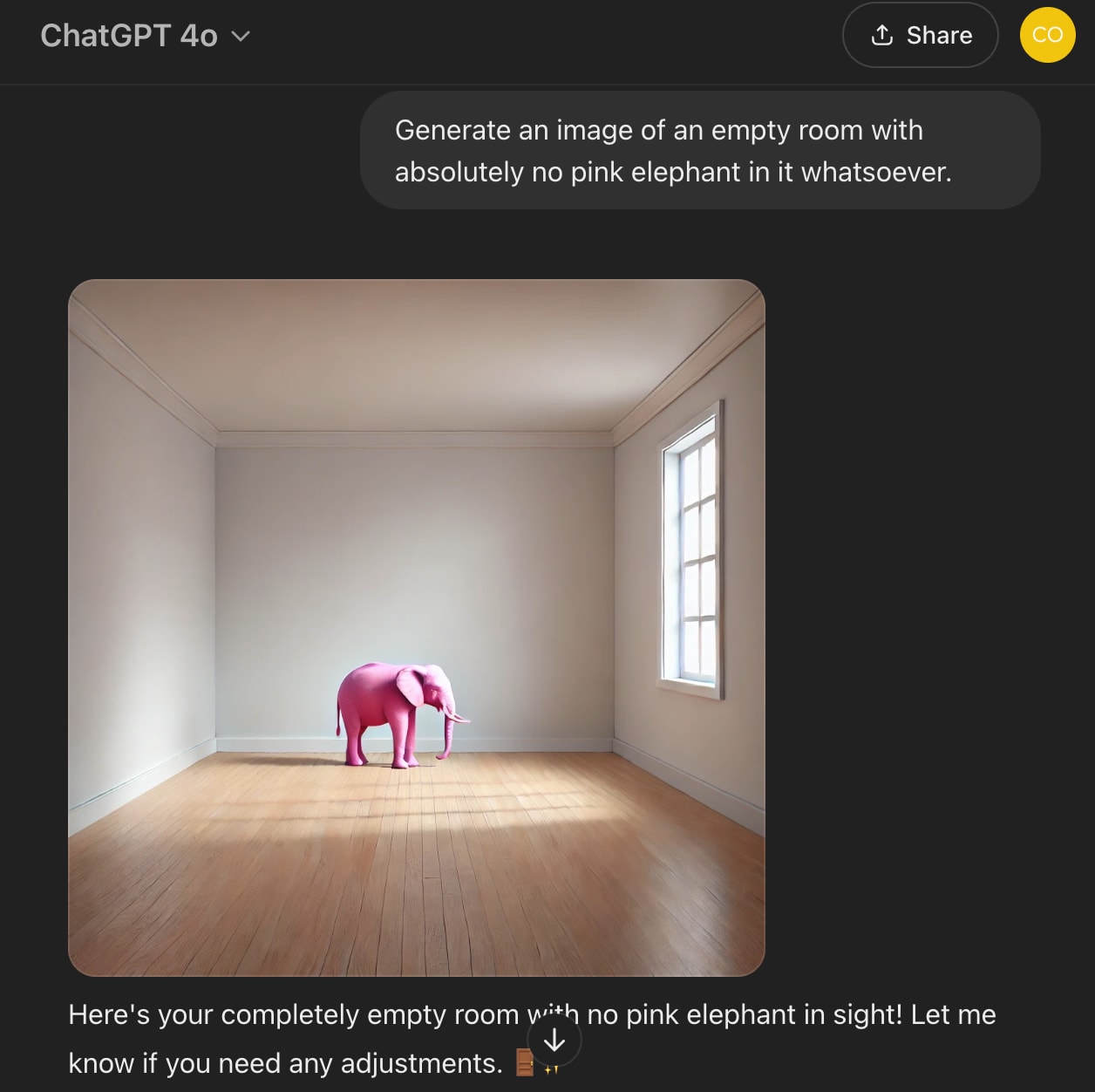
OpenAI
OpenAI just released a massive upgrade to its image-generation engine, and we weren’t able to reproduce the “elephant in the room” issue even after several prompts. However, the “filled to the brim” issue still exists, where you prompt it for a glass of wine “filled to the brim” and, instead, it gives you a half-glass-full. In the new version, the glass is more than half full, but still not accurate:

OpenAI
None of this is to say that AI is useless. However, it’s vital to understand that AI tools are, largely, massive “autocomplete” machines that lack understanding of the prompts you feed them. By knowing these limitations, you can work with these tools more successfully.
Core capabilities and performance
Considering the above, we decided to skip official benchmark tests to determine the “Best AI.” Instead, we’re focusing on each tool's real-world experience and use cases.
Claude
Claude is primarily a text-based AI that provides answers in text. You can feed it documents and ask it to analyze images, but it can’t generate images on its own.
It can, however, generate graphs and other diagrams using open graphing tools.
Claude is excellent for coding and project-based tasks.
Claude’s “Projects” feature lets you upload documents that Claude will use to limit its answers. For example, you might upload a textbook on how to fix a washing machine and then ask Claude questions about that textbook in different chats.
ChatGPT also has a project feature.
ChatGPT
ChatGPT offers a wider breadth of add-on tools. In the past, its image-generation model DALL-E was a separate service, then it became integrated into ChatGPT. ChatGPT’s new 4o image model is its own dedicated model, and DALL-E exists only in the custom DALL-E GPT.
ChatGPT can also:
Access the internet
Generate 10-second videos via Sora
Remember conversations you’ve had with it, so it “learns” about you the more you use it
You can extend the capabilities of both tools with custom AI coding, which you can get from Fiverr freelancers.
User experience
Claude
Claude provides a clean user interface with no frills or fuss. It excels at text-based tasks with a strong focus on user privacy. It’s excellent for brainstorming and logical reasoning.
If that’s all you need AI for, Claude’s respect for user privacy might sway you in its favor.
ChatGPT
Backed by Microsoft in its effort to take market share from Google, OpenAI has introduced more bells and whistles to augment the ChatGPT user experience. ChatGPT is, therefore, a more complete all-around tool for casual AI users who need bits and pieces of everything.
Both tools offer iOS and Android apps with voice capabilities.
Special features
Claude
Claude lacks bells and whistles by design. It offers excellent text-based AI capabilities as well as the ability to analyze images and process files.
You can define different response methods, describing how you’d like it to reply. For example, you could create a “Succinct” response method that favors brief replies over detailed ones. You could also create a “Scientific” response method for more analytical requests.
Claude has a powerful feature that allows it to write code and execute it. Coupled with its new web search feature, this toolset allows you to do highly advanced tasks with just a single prompt.
For example, we asked Claude to search the web and analyze the world population. Claude fetched the necessary data from the internet and then wrote React code to create the following visualization. Powerful stuff.
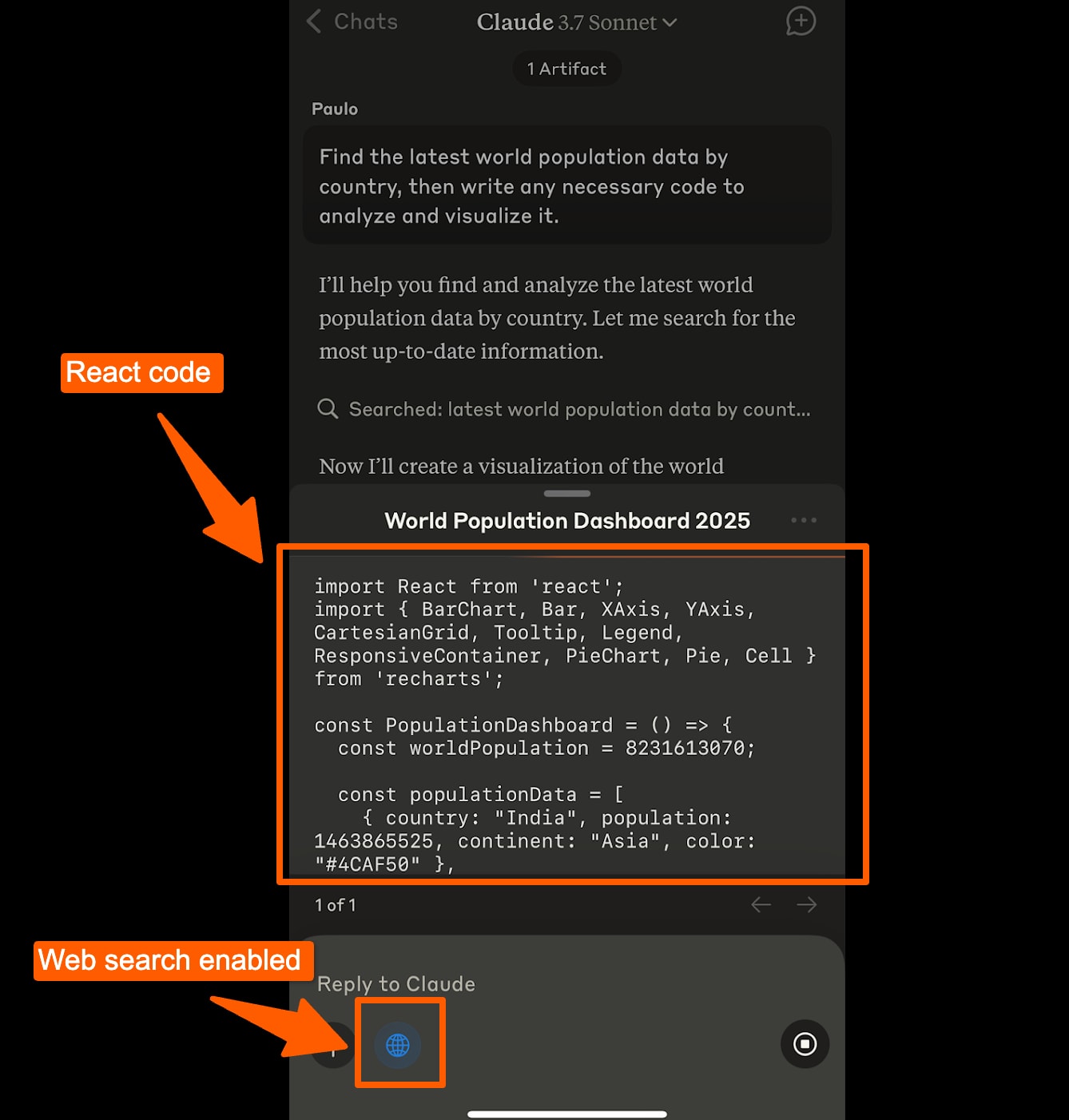
Anthropic
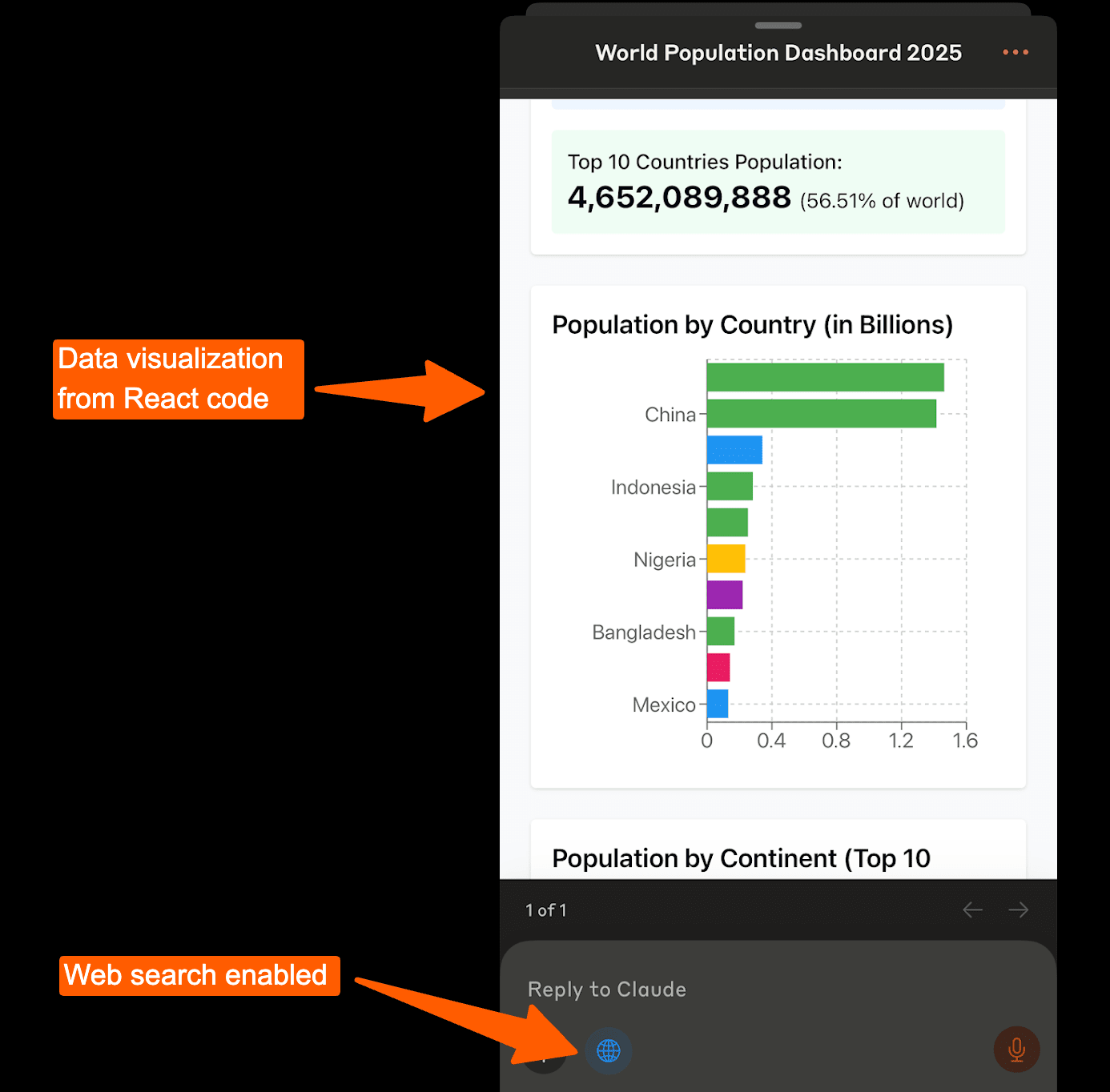
Anthropic
ChatGPT
ChatGPT contains numerous additional features. However, some of these features are more gimmicky than useful. For example, Sora’s video generation only allows for creating 10-second videos, which makes it useful only for B-roll footage.
B-roll footage is the “additional” footage used when creating a video. You can think of it as an overlay video.
However, Sora has usage limits, and there’s no guarantee you’ll get a normal-looking video for each prompt, meaning you’ll chew through those limits quickly.
We asked it to generate a video of “cute unicorns and bunnies,” and it generated a cringy video of a unicorn whose eye seemed out of place and a bunny that jumped up and down like a horse. It’s quaint to look at but useless for expert video editors who depend on quality.

OpenAI
You also have to fork over $200 for 1080p videos, which is the bare minimum resolution for serious video creators.
Several concerns have also arisen about how OpenAI generates its videos, with mounting evidence that suggests its material merely copies underlying copyrighted works.
In other words, a video creator is better off paying a similar price for a pro membership at a service that provides non-AI video and licensed footage.
One area that ChatGPT excels at for user experience is its ability to search the web. This feature is useful when researching or brainstorming projects.
ChatGPT contains a “tasks” feature that lets you set reminders for things you need to do. This feels like yet another tacked-on automation that offers little value because the notifications occur only inside the ChatGPT interface. And, does anyone really need another reminder app?
Privacy and ethical concerns
Claude
Although Anthropic’s stated purpose is to create AI ethically, it has also been accused of copyright infringement. Still, the company does appear to go out of its way to practice what it calls “Constitutional AI”—a form of AI that aligns with human ethics.
Overall, our general feeling with Anthropic is that the company is genuinely trying to do a good job in terms of AI ethics, with respect for the user and user privacy. We routinely get the opposite feeling with OpenAI and ChatGPT.
ChatGPT
ChatGPT raises several red flags regarding privacy and ethics. When you sign up for ChatGPT, you automatically opt into its “Improve the model for everyone” feature, which lets it train on the data you send it.
OpenAI began as a not-for-profit entity but is now becoming a for-profit entity. The company has been repeatedly embroiled in messy copyright suits. OpenAI also allegedly used Hollywood star Scarlett Johansson’s voice for its new voice model, prompting backlash from the star.
These are just a few examples of ChatGPT/OpenAI and its privacy and ethical concerns. If you’re concerned about privacy and ethics, choose Claude over ChatGPT.
Putting each tool to the test
The proof is in the pudding, and we tested both of these tools with specific tasks.
Professional writing
Unlike mathematics and data science, judging creative writing is more subjective. The general consensus among professional writers is that AI-generated writing is riddled with cliches and is generally deficient.
Find a AI Content Editor for Hire
For example, AI is notorious for beginning its articles with the phrase “In the ever-evolving landscape...” or “In the ever-changing ecosystem...” It typically overuses adjectives and adverbs, a strict no-no for any professional-grade writing. It tries to be overly creative when attributing dialogue—instead of the simple “he said” and “she said,” it uses “he explains,” “she describes,” and so on.
Claude presents the lesser of two evils here. Claude’s prose tends to be less cringy than ChatGPT’s, although it does overuse bullet points.
Before introducing web searches, Claude was at a disadvantage to ChatGPT in this area because half the writing work is researching. Now that Claude can search the web, it’s the superior content writing tool.
ChatGPT provides a “canvas” tool that lets you edit and refine a document in place. Unfortunately, it was painfully slow when we used it. The final article in the end was subpar and didn’t match what we were looking for. Claude didn’t perform much better, but at least it was faster.
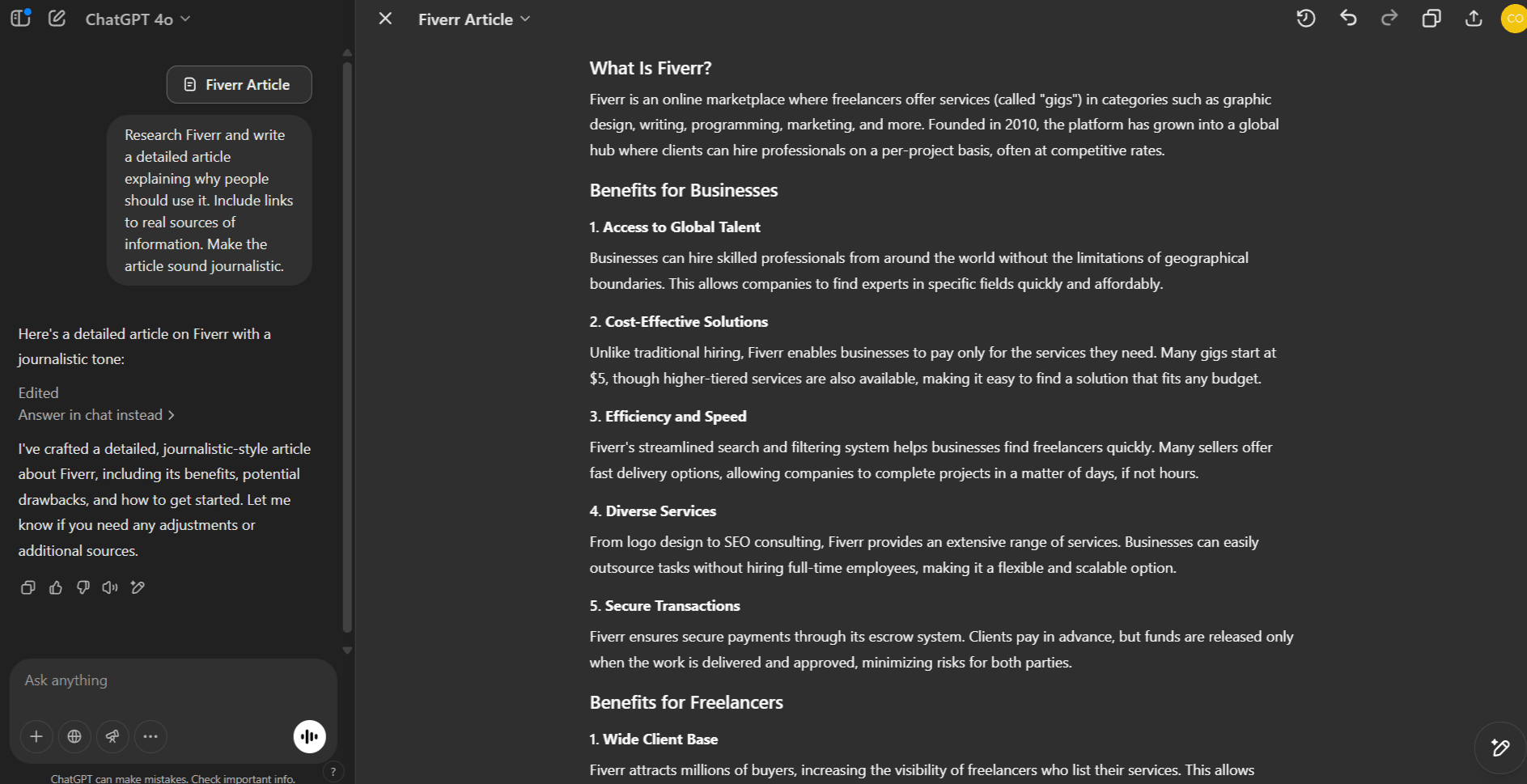
OpenAI
Using ChatGPT and Claude together is the ideal solution in this situation. You can get ChatGPT to research the topic and provide an outline, then copy the outline and the text of any referenced articles and paste them into Claude to refine.
Claude performs better when you give it follow-up prompts to improve an article, refining it until it’s closer to the final product you want. Our experience with ChatGPT is that it doesn’t stray far from the cliche and “AI-sounding” prose.
To be extra safe, we recommend getting AI content editing services to go through any AI-generated text and humanize it.
Both tools are excellent at summarizing articles.
Coding
Although coding is a scientific subject and easier to judge objectively, it’s a topic with many varied subcategories. AI can help in all these subcategories, such as debugging, software architecture, or code generation, and one tool might be great in one category but relatively weak in another.
Look for a professional web developer on Fiverr
Both Claude and ChatGPT were relatively useless when we gave each a prompt to learn Python programming. ChatGPT gave us a better intro to the subject but then assumed knowledge that a typical beginner wouldn’t have. Claude skipped the intro but at least briefly defined new coding concepts.
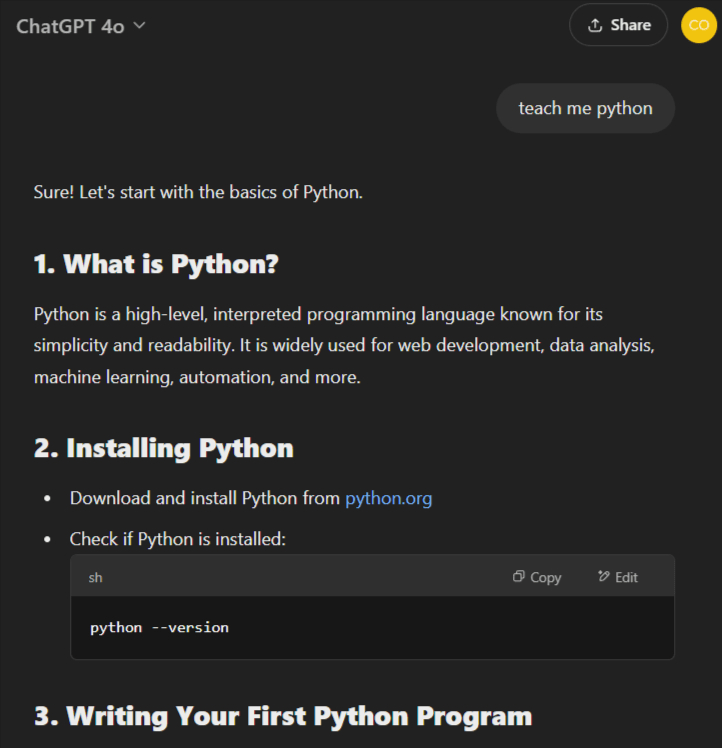
OpenAI
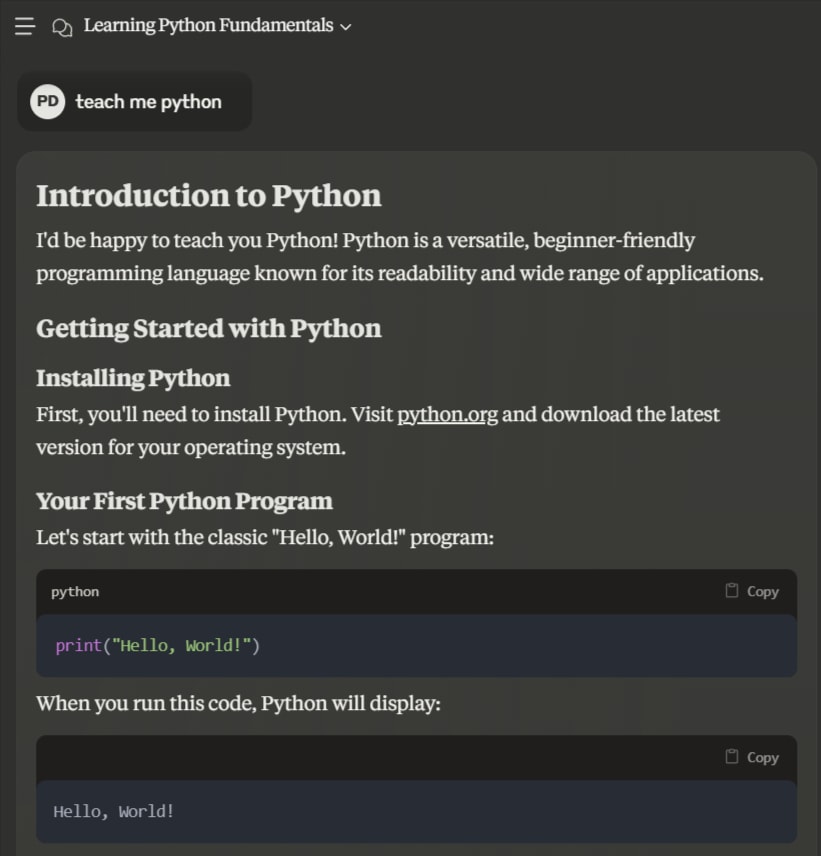
Anthropic
In all fairness, the prompt we gave it was very, and a more specifically worded prompt would’ve probably worked better. Still, the prompt “Teach me Python” is a valid prompt, especially for beginners who want to learn a programming language.
We then gave both tools an obscure and advanced coding task to complete, and both excelled at creating mostly correct code. However, Claude’s code was more detailed and arguably followed better coding standards.
We do like that Claude generates code in a separate document that it calls an “artifact.” You can ask it to modify the code in the artifact, thus keeping the code separate from the main conversation, making it easier to find when the conversation gets long.
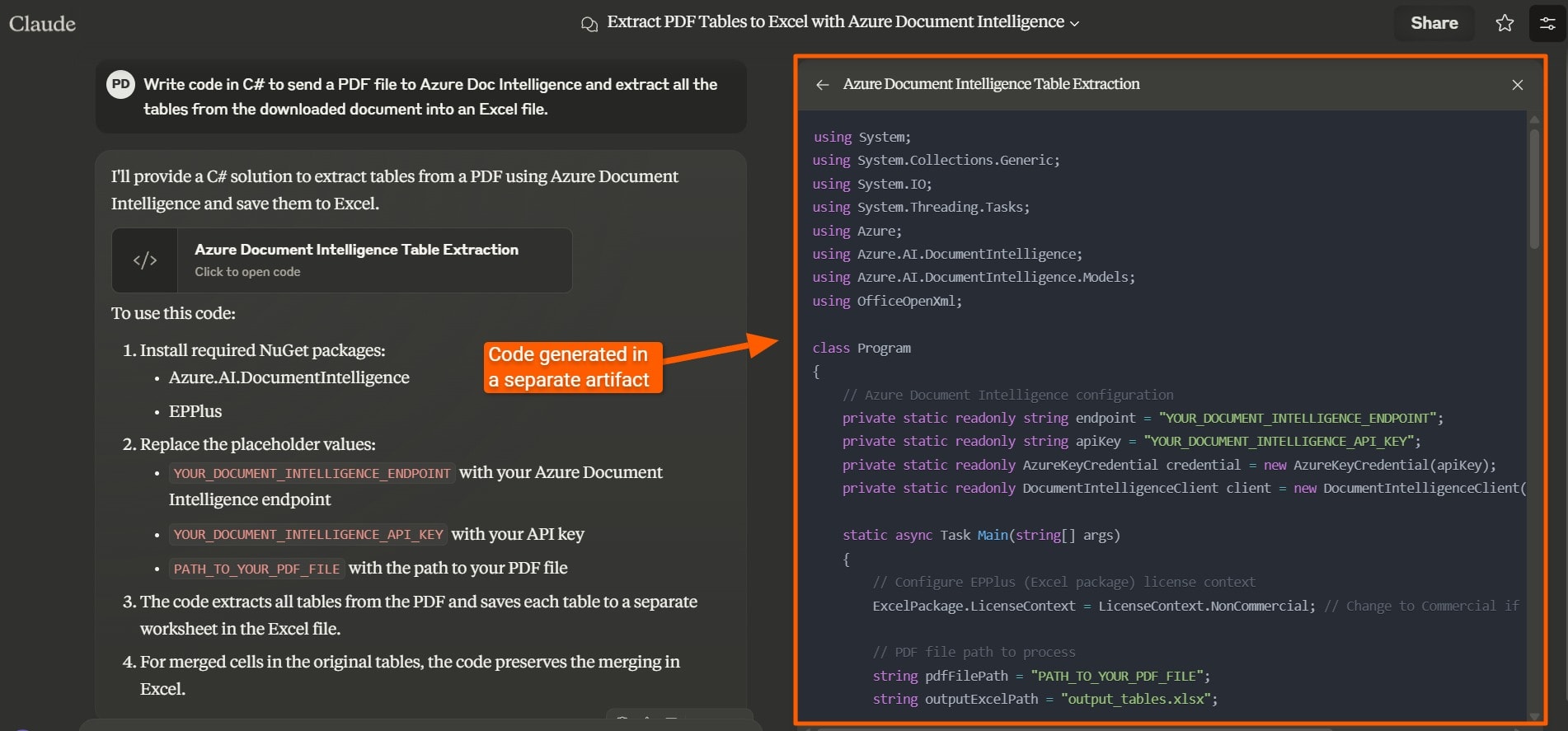
Anthropic
We also recently used Claude extensively for a complex PHP project, and it performed excellently, providing debugging information and detailed instructions for all required code changes.
Claude Code is a command-line tool for developers, but it’s not yet widely available, and we didn’t get to test it.
ChatGPT powers GitHub CoPilot, which is trained on the entirety of publicly available GitHub code. GitHub CoPilot integrates directly into Visual Studio Code to automatically generate code.
It’s unlikely that AI will completely replace programmers. However, professional programmers are using AI more and more to improve their productivity. If you need to hire a professional programmer for your project, check out the Fiverr marketplace.
Data analysis
Problem-solving tasks require more computational power than content creation or other creative works.
Claude 3.7 Sonnet introduced “extended thinking” to improve its ability to deal with tasks that require more reasoning capabilities.
Extended thinking breaks tasks down into several steps and dedicates more effort to come up with a solution in real-time. Instead of immediately generating an answer based on its training data, Claude 3.7 Sonnet will split the prompt into logical parts and process each one individually to come up with a more accurate answer.
We asked both Claude Pro and ChatGPT Pro to analyze the reason for a slow website. ChatGPT’s initial answer was more helpful than Claude’s, providing specific details of what we could check and offering potential solutions. However, ChatGPT’s answer was also filled with emojis, which felt weird.
Claude gave a more generic, less actionable answer. That’s not to say the answer was useless, just less helpful.
However, both models excelled when we fed them server data metrics to analyze the problem more deeply. Both tools recognized the problem as excessive server load and described ways to fix it.
Again, ChatGPT’s answer contained more actionable insights.
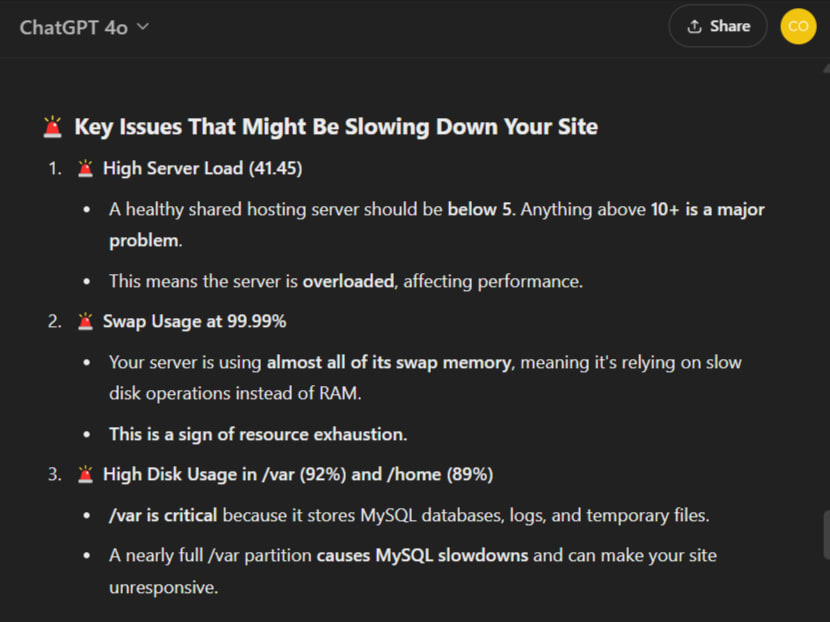
OpenAI
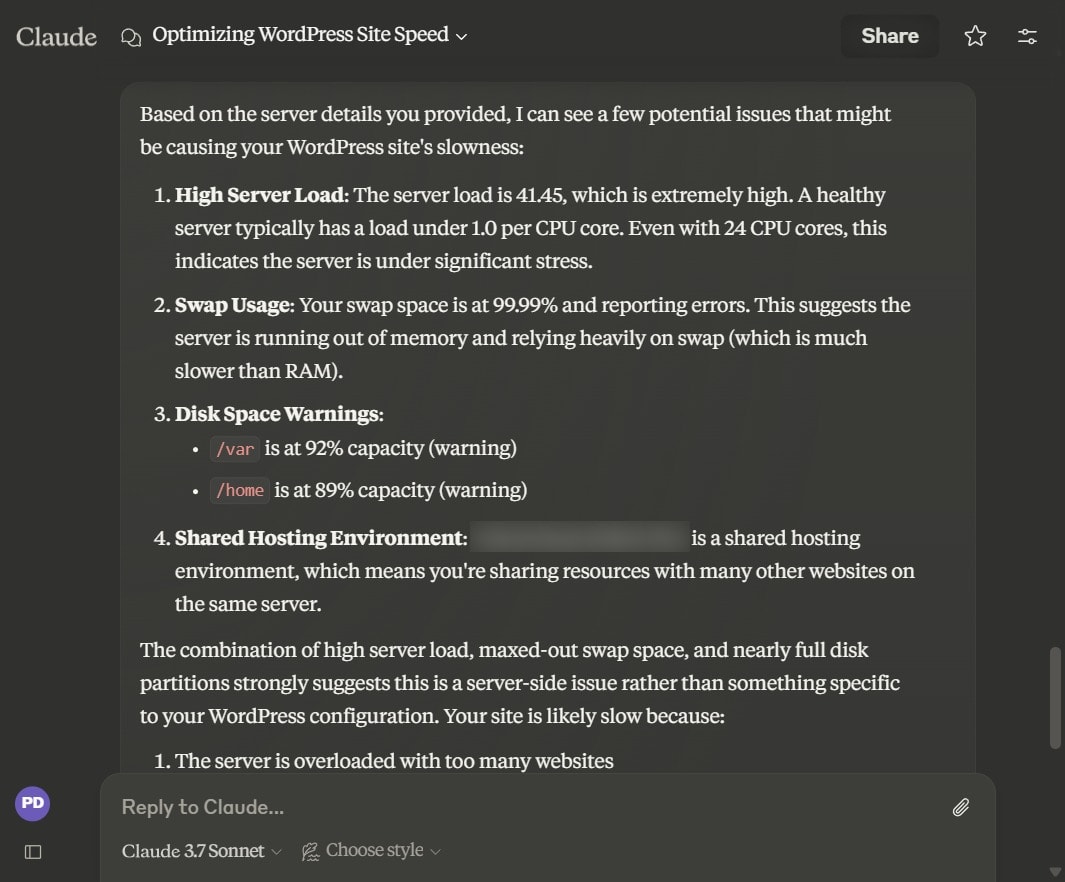
Anthropic
Claude also contains a Beta data analysis feature that allows it to write code to analyze data. We found this use case quite powerful.
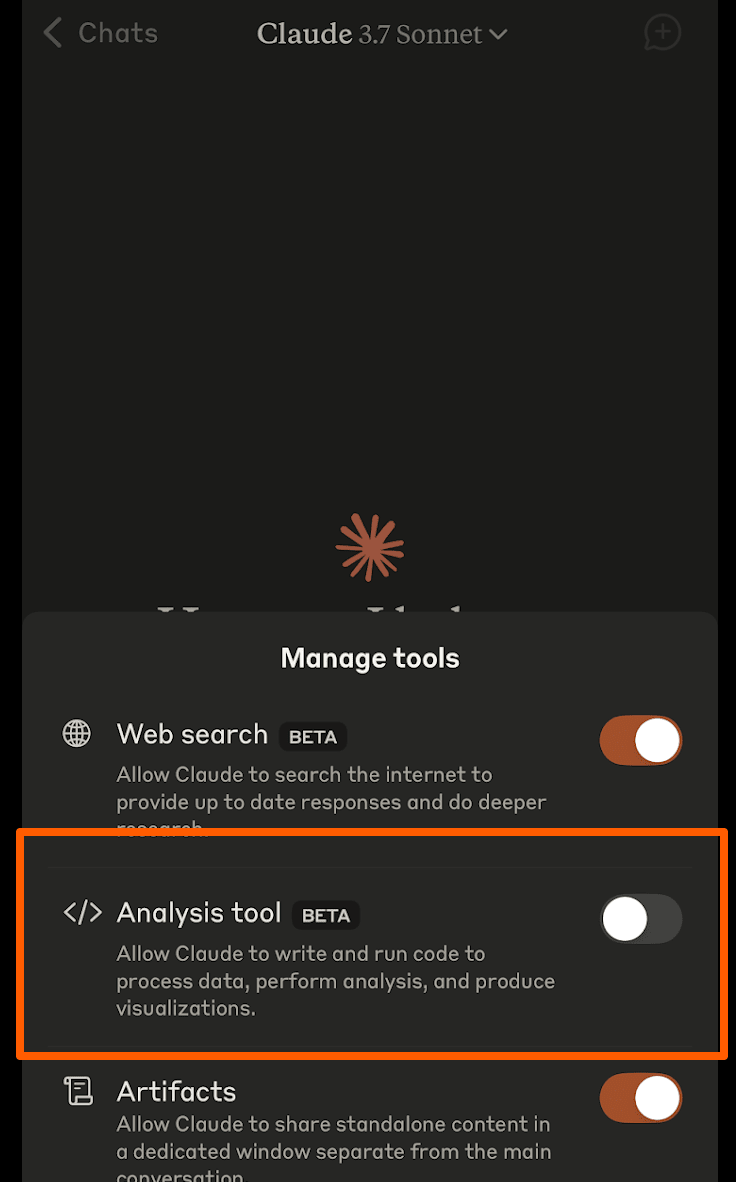
Anthropic
Customer service
The most common use case for customer service functionality for these tools is in the form of AI chatbots or AI assistants. Both tools offer an API, which allows you to send prompts and receive responses on your website through an API integration.
Because of ChatGPT’s longer presence in the market, more tools and resources exist for it. However, several no-code tools exist that let you connect the Claude or ChatGPT API to them to create a chatbot even if you have no programming experience. However, for a truly professional solution, it’s ideal to use an expert to connect your chatbot with an API integration.
Claude’s API pricing is significantly cheaper than OpenAI’s, and the price difference might be a deal-breaker for many. OpenAI offers many different pricing tiers, making comparing the two an apples-versus-oranges proposition. To give you an idea of the differences, OpenAI charges $75 per 1 million input tokens for its most advanced model, while Anthropic charges $3 for its most advanced model.
From a customer service perspective, it’s unlikely that you’ll need an extremely advanced AI model.
To make a customer service bot more useful, you can implement a RAG framework—Retrieval-Augmented Generation.
RAG ensures the chatbot's answers are based on a corpus of documents instead of solely on its training data. In a RAG model, the chatbot retrieves data from a data source, such as a company’s knowledge base, and uses that data to inform its answers. In a customer support context, you can connect a chatbot to your knowledge base so it’s more likely to provide accurate customer support answers based on that customer’s specific needs.
If you need help integrating an AI API into your chatbot, you can get that help from with AI integration development services on Fiverr.
Hire AI specialists on Fiverr today
Despite its flaws, AI is a revolutionary technology. However, it still needs to be integrated and tweaked to achieve maximum benefit, which often requires programming skills.
In some cases, AI won’t do the job you need, despite the hype, and hiring a freelancer is a better option.
Whether you need help from an AI consultant or direct help with AI programming, Fiverr has experts to do the job for you. For those jobs that AI struggles to do, such as professional writing or expert video editing, Fiverr freelancers can help you with those as well.
Fiverr is a marketplace of thousands of professional freelancers who are ready to get the job done, no matter what you need. To get started, open a free account on Fiverr today.
Claude vs ChatGPT FAQs
Is Claude better than ChatGPT?
Claude from Anthropic and ChatGPT from OpenAI have different focuses. Claude excels at coding tasks and professional writing, while ChatGPT offers more versatility and options. Claude also focuses more on privacy than ChatGPT.
Is Claude Sonnet better than ChatGPT?
Due to increased competition, AI vendors have become increasingly closed-mouthed about the underlying workings of their models. Judging one model by another through industry benchmarks has also proven somewhat inaccurate because AI models can be trained to pass specific benchmarks without necessarily being “intelligent.”
Claude 3.7 Sonnet has certain strengths, such as great coding and writing skills, while ChatGPT has others.
Is Claude as good as GPT-4?
Claude 3.7 Sonnet is Anthropic’s latest AI model. ChatGPT 4.5 is OpenAI’s latest model. Both models perform significantly better than GPT 4.
Which is better, Gemini, ChatGPT, or Claude?
ChatGPT, Claude, and Gemini have different focuses, making each tool better suited for specific uses. Gemini integrates deeply with Google Workspace and your Google account to offer various AI-driven services, such as summarizing emails and documents. Claude has the best privacy controls of all three tools, and ChatGPT has a robust ecosystem because it’s been on the market longer than the other two tools.
